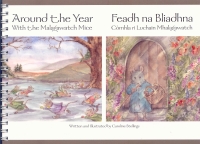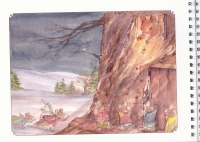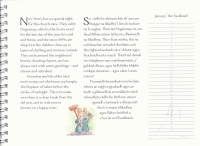| ________________
CM . . .
. Volume XVIII Number 37. . . .May 25, 2012 
 |
Around the Year with the Malagawatch Mice = Feadh na Bliadhna Còmhla ri Luchain Mhalagawatch.
Caroline Stellings. Gaelic translation by Effie Rankin.
Sydney, NS: Cape Breton University Press, 2011.
32 pp., spiral bound, $11.95.
ISBN 978-1-897009-66-6.
Preschool-grade 2 / Ages 4-7.
Review by Dave Jenkinson.
*1/2 /4
|
| |
|

excerpt:
The first day of February is St. Bridget's Day, which is also called Imbolc or Candlemas. It is an ancient holiday that heralds the return of Spring. Grandpa lights a candle every year to mark this time when the days get longer and the sun seems a bit brighter.
The children love February because the pond is frozen over and they can skate. No matter how wintry the air, or how cold their feet, once they get moving they never want to stop.
Caroline Stellings first introduced youngsters to the church-dwelling mice in her 2004 book, The Malaqawatch Mice and the Church That Sailed, and she continued their story in 2009, adding a new character, an orange cat named Henry, in The Malagawatch Mice and the Cat Who Discovered America.
 In Around the Year with the Malagawatch Mice, each of a dozen pairs of facing pages deals with a single month of the year, starting with January. A full page is given over to a watercolour illustration that shows one or more of the mice engaged in some activity related to the two-column text on the opposite page. The brief text, rendered in English and Gaelic, usually connects something linked to Cape Breton's Scottish/Irish heritage and the month under consideration. For instance, June 9th is the day "set aside to honour the life of Saint Columba, or Calum Cille, a very special saint." In December, "Grandma [mouse] bakes a Dundee cake [a traditional Scottish fruit cake], and the aunts and mothers make 'black bun,' [a type of fruit cake completely covered in pastry] which is full of raisins and cinnamon." Sharing each month's text page is a page from a "birthday/anniversary" calendar, i.e. just a line for each "numbered" day of the month, but not the "day," such as Monday, Tuesday, etc.
In Around the Year with the Malagawatch Mice, each of a dozen pairs of facing pages deals with a single month of the year, starting with January. A full page is given over to a watercolour illustration that shows one or more of the mice engaged in some activity related to the two-column text on the opposite page. The brief text, rendered in English and Gaelic, usually connects something linked to Cape Breton's Scottish/Irish heritage and the month under consideration. For instance, June 9th is the day "set aside to honour the life of Saint Columba, or Calum Cille, a very special saint." In December, "Grandma [mouse] bakes a Dundee cake [a traditional Scottish fruit cake], and the aunts and mothers make 'black bun,' [a type of fruit cake completely covered in pastry] which is full of raisins and cinnamon." Sharing each month's text page is a page from a "birthday/anniversary" calendar, i.e. just a line for each "numbered" day of the month, but not the "day," such as Monday, Tuesday, etc.
The principal problem with Around the Year with the Malagawatch Mice is that it's a book in search of an audience. It has no plot to keep the young readers of Stellings' earlier Malagawatch Mice books engaged. In fact, if youngsters haven't previously encountered the two earlier volumes, they will have no way at all of identifying or connecting with the characters in Around the Year with the Malagawatch Mice. Simultaneously, the volume's content is too mature for a juvenile audience and too juvenile for an adult audience. The text's factual portions need to be connected to a "notes" section at the end of the book so that readers do not have to search elsewhere for clarifying details. For example, why should September 29, Saint Michael's Day, be of significance to those living on Cape Breton Island?
 If the book was really meant to be one of those calendars on which a person records birthdays, anniversaries and other significant events that occur annually, then the wire spiral binding needed to be at the top, not on the side, so that the "book" could be hung up like a calendar.
If the book was really meant to be one of those calendars on which a person records birthdays, anniversaries and other significant events that occur annually, then the wire spiral binding needed to be at the top, not on the side, so that the "book" could be hung up like a calendar.
Though Around the Year with the Malagawatch Mice might have some local interest for those who live in Nova Scotia, and especially on Cape Breton Island, for the rest of Canada it is a volume that likely can be passed over.
Not recommended.
Dave Jenkinson, CM's editor, lives in Winnipeg, MB.

To comment
on this title or this review, send mail to cm@umanitoba.ca.
Copyright © the Manitoba Library Association. Reproduction for personal
use is permitted only if this copyright notice is maintained. Any
other reproduction is prohibited without permission.
NEXT REVIEW |
TABLE OF CONTENTS FOR THIS ISSUE
- May 25, 2012.
AUTHORS |
TITLES |
MEDIA REVIEWS |
PROFILES |
BACK ISSUES |
SEARCH |
CMARCHIVE |
HOME |

 In Around the Year with the Malagawatch Mice, each of a dozen pairs of facing pages deals with a single month of the year, starting with January. A full page is given over to a watercolour illustration that shows one or more of the mice engaged in some activity related to the two-column text on the opposite page. The brief text, rendered in English and Gaelic, usually connects something linked to Cape Breton's Scottish/Irish heritage and the month under consideration. For instance, June 9th is the day "set aside to honour the life of Saint Columba, or Calum Cille, a very special saint." In December, "Grandma [mouse] bakes a Dundee cake [a traditional Scottish fruit cake], and the aunts and mothers make 'black bun,' [a type of fruit cake completely covered in pastry] which is full of raisins and cinnamon." Sharing each month's text page is a page from a "birthday/anniversary" calendar, i.e. just a line for each "numbered" day of the month, but not the "day," such as Monday, Tuesday, etc.
In Around the Year with the Malagawatch Mice, each of a dozen pairs of facing pages deals with a single month of the year, starting with January. A full page is given over to a watercolour illustration that shows one or more of the mice engaged in some activity related to the two-column text on the opposite page. The brief text, rendered in English and Gaelic, usually connects something linked to Cape Breton's Scottish/Irish heritage and the month under consideration. For instance, June 9th is the day "set aside to honour the life of Saint Columba, or Calum Cille, a very special saint." In December, "Grandma [mouse] bakes a Dundee cake [a traditional Scottish fruit cake], and the aunts and mothers make 'black bun,' [a type of fruit cake completely covered in pastry] which is full of raisins and cinnamon." Sharing each month's text page is a page from a "birthday/anniversary" calendar, i.e. just a line for each "numbered" day of the month, but not the "day," such as Monday, Tuesday, etc.
 If the book was really meant to be one of those calendars on which a person records birthdays, anniversaries and other significant events that occur annually, then the wire spiral binding needed to be at the top, not on the side, so that the "book" could be hung up like a calendar.
If the book was really meant to be one of those calendars on which a person records birthdays, anniversaries and other significant events that occur annually, then the wire spiral binding needed to be at the top, not on the side, so that the "book" could be hung up like a calendar.